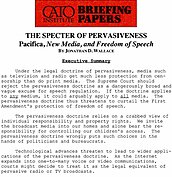The pervasiveness doctrine relies on a crabbed view of individual responsibility and property rights. We invite the broadcast media into our homes and alone bear the responsibility for controlling our children’s access. The pervasiveness doctrine wrongly puts such choices in the hands of politicians and bureaucrats.
Technological advances threaten to lead to wider applications of the pervasiveness doctrine. As the Internet expands into one-to-many voice or video communications, courts might decide to treat it as the legal equivalent of pervasive radio or TV broadcasts.

